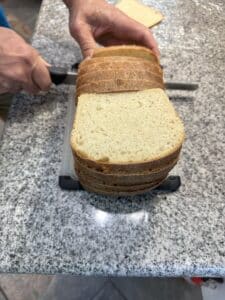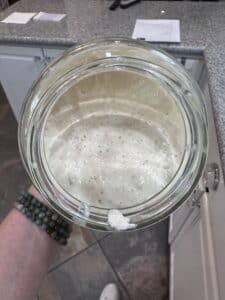Welcome to our cozy corner of the world! Here at Alpine Bed and Breakfast, we take pride in our homemade, gourmet breakfasts that leave our guests raving. Today, we’re excited to share something close to our hearts: our beloved sourdough starter. This blog serves a dual purpose: we’ll show you how to reactivate our dried sourdough starter and introduce you to a phenomenal sourdough sandwich bread recipe by Jake Widmann that has become a staple in our kitchen.
A Slice of Sourdough History

Slicing our sourdough sandwich bread
Did you know that sourdough is one of the oldest forms of grain fermentation? Its roots trace back to ancient Egypt over 4,000 years ago. Unlike commercial bread, sourdough uses wild yeast and lactic acid bacteria for fermentation, giving it that distinctive tangy flavor and a longer shelf life.
Sourdough’s unique taste is influenced by the local environment, making each starter different. During the California Gold Rush, miners carried sourdough starters with them, earning the nickname “sourdoughs.” One famous story is about Isidore Boudin, a French baker in San Francisco, whose starter from 1849 is still in use today!
Health Benefits of Sourdough
One of the reasons sourdough has stood the test of time is its health benefits. Sourdough is easier to digest than other breads because the fermentation process breaks down gluten and phytic acid, which can cause digestive issues. The natural bacteria in sourdough pre-digest these compounds, making it gentler on your stomach. Additionally, the fermentation process increases the bioavailability of nutrients, making it a more nutritious choice.
We’ve been using our sourdough starter since we started this adventure in 2019, and we recently started drying it to make it easier for guests to order or take with them. So, if you’ll be using our starter and are ready to activate it, this is where you’ll start. Jump down to the Sourdough Sandwich Bread Recipe if you already have a sourdough starter and are ready to start baking.
Reactivating Your Dried Sourdough Starter
- Add the dried starter to 1 Tbsp. flour and 1 Tbsp. of room temperature water in a quart-size glass jar and stir thoroughly. Cover the jar with a coffee filter or breathable material secured with rubber band and place in a warm place (70-80°F) for 12-24 hours.
- After 12-24 hours, feed the starter with an additional 2 Tbsp. of flour and 2 tbsp water. Stir thoroughly.
- After another 12-24 hours, feed the starter with an additional 1/4 cup of flour and 1/4 cup water. Stir thoroughly.
- Your starter should have the consistency of pancake batter; add flour or water to adjust as necessary.
- You’re looking for your starter to bubble between feedings, which is the fermentation at work!
- Continue to feed the starter with an additional ½ cup of flour and ½ cup water after 12-24 hours. Stir thoroughly.
- Discard down to ½ cup starter and then feed the starter with ½ cup water and ½ cup flour. Stir thoroughly.
- Repeat step 5 every 12-24 hours for 3-7 days. Do this until the starter has the consistency of pancake batter and is bubbling regularly within a few hours of feeding. That’s when your starter is activated and ready to use!

Sourdough starter that’s ready to use
If you plan to make bread every day, store the starter in a glass jar with a loosely tightened lid on the counter. If, like most people, you won’t need it that often, store the jar in the refrigerator and feed it once a week by discarding it back to 1/2 cup and adding as much water and flour. Feed it as many times as necessary throughout a couple of days to get the quantity you need for your recipe; don’t overfeed it as this can cause the starter to become diluted and weak.
And don’t worry if you forget to feed it. Sourdough starter is fairly resilient and won’t go bad that easily. It can go dormant if not fed but will come back to life once you start feeding it again. It’s important to note that a blackish liquid that separates from the starter doesn’t mean it’s bad. That’s “hooch”, an alcohol that’s a byproduct of the fermentation process. It forms when there’s no more food left and the starter is hungry. Just stir it back in and start the feeding process.
Red flags in a starter that’s gone bad are orange, blue, green or pink spots or streaks of mold that may or may not be fuzzy. Fuzziness and/or color is never good. Mold can form on the sides of the jar or the top of the starter, but regardless of where you find it the starter cannot recover and must be thrown away.
Ongoing Sourdough Feedings
Sourdough is so easy to care for. Mix 200 grams of starter with 200 grams of unbleached all-purpose flour, and 200 grams of water. Or you can use 100 grams of each or even 300 grams of each; just be sure the starter, water, and flour are in equal measurements. Stir to incorporate. Cover with a coffee filter secured with a rubber band. Let it sit on the counter until it doubles or starts to deflate. An active, healthy starter can even triple in size. Once it starts to deflate it is considered “discard”.
It’s important to avoid overfeeding the sourdough as it will make it unhealthy. Take the time to expand your stock over a couple of days if you need more starter than what you have. If you don’t like throwing away discard, there are many online recipes with ideas for using it!
Jake Widmann’s Sourdough Sandwich Bread

Jake Widmann holding his sourdough sandwich loaves
We recently discovered a sourdough bread recipe by Jake Widmann that doesn’t use any added yeast and produces a phenomenal loaf. Jake’s approach to sourdough is detailed and meticulous, ensuring great results every time. Below is the printed recipe, and this is a link to Jake’s Instagram post so you can see how to stretch and fold the dough. We’ve added some TIPS, which we noted below the recipe.
Sourdough Sandwich Bread
INGREDIENTS:
650 grams water at (2 3/4 cups)
300 grams active starter* (1 1/4 cups)
20 grams sea salt (1 tbsp)
20 grams sugar or honey (1 tbsp)
20 grams olive or avocado oil (1 tbsp)
1000 grams all-purpose flour (8 cups)
DIRECTIONS:
- Mix together water and starter, then add salt, sugar, and oil. Stir, then mix in flour until you have a uniform dough. Cover your bowl and let rest for 30 mins.
- Grab one part of the dough, stretch it up and fold it on top of the rest. Rotate bowl 90 degrees and repeat until you’ve folded all four “corners.” Repeat every 30 minutes for a total of 3x. Let rest until dough has doubled. (see Instagram video for a visual).
- Pour onto a floured surface and divide into 2 equal halves.
- Grab 1 corner of the dough to stretch and fold it on top of itself. Perform this 4 times for each corner of the dough. Place your loaves seam side down in a greased bread pan to rise. Cover. Once they’ve risen to the top of the bread pan they’re ready to bake.
- Preheat oven to 400° F. Place a cookie sheet in the oven with 1-2 cups of water in it.
- Place both loaves into the oven and bake for 12 mins. After 12 mins remove the water pan. Bake your loaves for another 20 mins. Take out of the oven and remove from the bread pans—this is a must.
- Let loaves cool before slicing into.
- Freeze any loaves you aren’t going to eat within a few days by placing them into a bag. Place the loaf you’re eating in a bag as well and always seal shut. It will last a week or more if bag is kept shut.
TIPS from Alpine Bed and Breakfast *:
- We highly recommend measuring the ingredients by weight/grams, not cups/volume! Measuring by volume, especially flour and other dry ingredients, can produce drastically different amounts by weight. We first tried this bread using the measurements in cups and the dough was too dry.
- Active starter has been fed within the last 12 hours or so and is growing until it hits its peak (at least doubles). Once it begins to fall it is considered discard.
- Let the dough rest for 15 minutes before placing it in the bread pan as stated in Step 4. This will allow the dough to loosen so you can evenly stretch it from one end of the pan to the other, enabling a more even rise across the top of the pan.
- This dough has no extra added yeast, so it can take longer to rise than a regular loaf. You can put the loaves in a cold oven with a bowl of warm water to hasten the process. DO NOT USE THE PROOF SETTING ON YOUR OVEN, IF IT HAS ONE. We tried that but the temperature was too high, causing the tops to dry out and preventing the loaves from rising during baking. If you run out of time to let the dough rise before the bake, you can cover the pans with oiled plastic wrap and place them in the fridge overnight. We sometimes do this at the B&B when we run out of time. Just remove it from the fridge in the morning and begin the rising process
- Allow the entire top of the loaf to rise to the top of the pan before baking, not just the center. Allowing the ends to rise to the top will give you a more uniform loaf. This is also why you want to rest the dough before placing it in the pan.
Experience the Best of Alpine Bed and Breakfast

Strawberry pancakes made from sourdough discard, served with butter and maple syrup
Our sourdough starter isn’t just for bread! We use it to create a variety of delicious dishes, like our Monte Cristo Alpine B&B Style – a ham and Swiss sandwich with apple slices and apple cider jelly, soaked in a savory French toast batter, grilled to perfection and served with homemade strawberry compote. We also use the starter discard to make sourdough blueberry pancakes that we serve with real maple syrup.
We hope you enjoyed this deep dive into the world of sourdough. Why not come and experience it for yourself? Book a stay at Alpine Bed and Breakfast and savor our homemade, gourmet breakfasts. Visit our website for more details, check out our breakfast page, and explore the many amenities we offer on our rooms page.
Have you tried making sourdough with our starter or creating Jake’s sandwich bread? Share your experiences in the comments below. We love hearing from you!
Contact Us
For more information or to inquire about availability, please contact us at:
Phone: (432) 538-7032
Email: innkeeper@alpinetxbnb.com
We look forward to welcoming you to Alpine Bed and Breakfast, where unforgettable memories are made.
Sharon & Tom
Alpine Bed and Breakfast
www.alpinetxbnb.com

A morning sample of Alpine Bed and Breakfast – Monte Cristos made with sourdough bread and served with strawberry compote, scrambled eggs, smoked sausage, and skillet sweet potatoes
